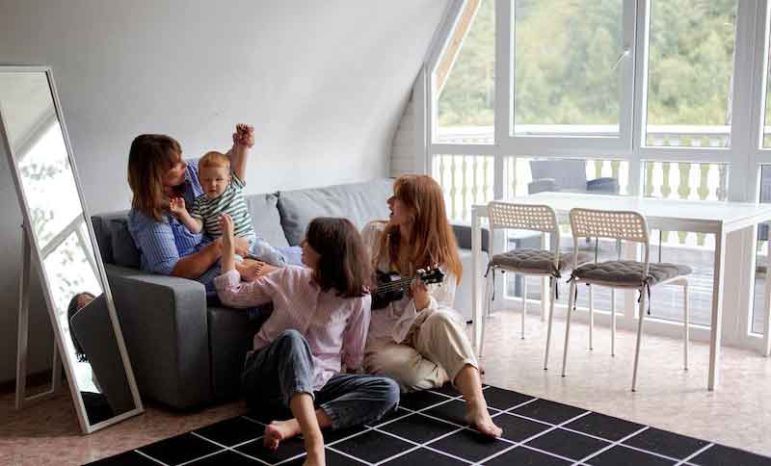In an era marked by the hustle and bustle of modern life, the concept of multigenerational living is experiencing a renaissance. More and more families are recognizing the benefits of bringing multiple generations together under one roof. This age-old practice is making a comeback, and it’s not just about saving money or sharing chores; it’s about fostering strong family bonds, enhancing support networks, and creating a more sustainable and enriching way of life. In this blog post, we’ll explore the advantages of building a multigenerational home, and why it might just be the key to a happier, healthier, and more harmonious family life.
Strengthening Family Bonds
One of the most significant advantages of living in a multigenerational home is the opportunity it provides for strengthening family bonds. When multiple generations share the same living space, they have the chance to interact daily, share experiences, and build deeper connections. Grandparents can play a more active role in the lives of their grandchildren, sharing stories, and wisdom, and creating cherished memories. Children, in turn, learn to respect and appreciate the experiences of their elders, leading to a more profound sense of family unity.
Emotional Support System
Life is full of ups and downs, and having a multigenerational household can provide a built-in support system during challenging times. Whether it’s navigating a difficult career choice, dealing with a personal crisis, or simply seeking advice, having family members from different generations can offer diverse perspectives and a strong emotional safety net. The presence of grandparents, parents, and children creates a nurturing environment where everyone can lean on each other when needed.
Cost Savings
While building a multigenerational home may require some upfront investment in terms of construction or renovation, the long-term financial benefits are often significant. Shared living expenses such as mortgage payments, utilities, and groceries can lead to substantial cost savings for all family members. This financial relief can enable families to allocate resources to other important goals, such as education, travel, or retirement planning.
Shared Responsibilities
In a multigenerational home, responsibilities are shared among family members. This can ease the burden on any one individual and create a more balanced lifestyle for everyone. Grandparents can help with childcare, while younger generations can assist with tasks like grocery shopping, cooking, and home maintenance. This sharing of responsibilities fosters a sense of interdependence and cooperation within the family.
Cultural and Educational Exchange
Multigenerational homes are often a melting pot of diverse perspectives and experiences. This environment can be incredibly enriching, especially for children. Grandparents can pass down cultural traditions, languages, and family history, preserving important aspects of heritage. Additionally, children benefit from exposure to different generations’ knowledge and life experiences, which can contribute to their personal growth and development.
Enhanced Security
Having multiple generations living together can enhance the overall security of the household. Whether it’s having someone to look after the home when others are away or providing care for elderly family members, the presence of various generations ensures that there is always someone available to address safety and security concerns.
Environmental Sustainability
From an environmental standpoint, multigenerational homes can be more sustainable. Sharing resources and living spaces can reduce the environmental footprint of each household member. This can include energy-efficient appliances, shared transportation, and more mindful consumption practices. By reducing the overall consumption of resources, multigenerational living contributes to a more sustainable and eco-friendly lifestyle.
Retirement Planning
For older generations, living in a multigenerational home can provide a practical solution for retirement planning. It allows grandparents to downsize their living arrangements while maintaining a sense of independence and support. The financial benefits of shared expenses can free up funds for retirement savings and leisure activities, ensuring a comfortable and fulfilling retirement.
Preserving Family Values
In today’s fast-paced world, family values and traditions can easily get lost in the shuffle. Multigenerational living allows for the preservation and passing of these values from one generation to the next. Whether it’s teaching the importance of respect, responsibility, or compassion, living together encourages the transmission of these core values that are the bedrock of a strong family unit.
Quality Time
In a world dominated by screens and distractions, one of the most precious commodities is quality time spent with loved ones. Multigenerational living facilitates this by creating an environment where family members can come together for meals, celebrations, and everyday conversations. It helps families prioritize connection over isolation, leading to happier and more fulfilling lives.
In conclusion, building a multigenerational home is a decision that goes beyond mere convenience or financial considerations. It’s a choice that can transform family dynamics, foster deep emotional connections, and create a sustainable and enriching way of life. By living together under one roof, multiple generations can experience the many advantages that come with shared responsibilities, emotional support, and the preservation of family values. If you’re looking to enhance your family life and create lasting memories, consider the benefits of multigenerational living – a lifestyle choice that’s as timeless as it is rewarding.


